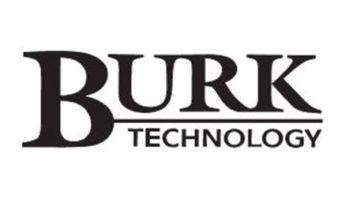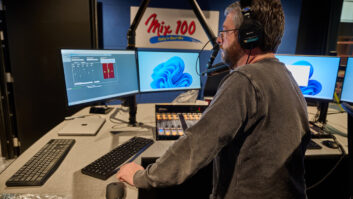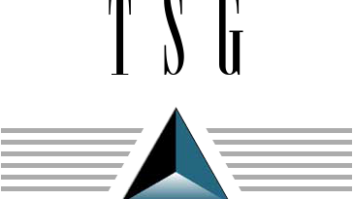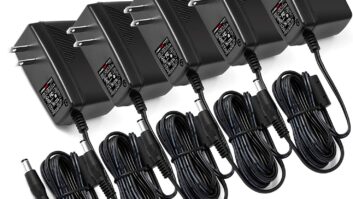Kinko’s and other copy centers can do marvelous things. Copying your large transmitter schematics is one.
Laminate the enlarged, copied schematic and post it on the wall, and you’ve got a simpler means of troubleshooting in which you’re not hunched over a desk. In addition, your schematic won’t get ripped or ruined.
(click thumbnail)Fig. 1: Grease pencils can be used on a plastic-covered schematic
Add a grease pencil and the troubleshooting is even easier. Use the grease pencil to mark components that have been checked or to isolate parts in a failed section. The pencil also helps when you’re on the phone with a manufacturer’s field service rep.

. . .
Several engineers have asked why broadcasters couldn’t use the smaller TV satellite receive dishes instead of the larger 3 meter dishes to receive syndicated broadcast audio programs.
You may wonder, too. After all, the syndicated audio bandwidth is a lot less than that of a television signal; and if the little dishes could pick up all the satellite offerings from Dish Network or DirecTV, they should work with the limited audio bandwidth signals.
A plausible argument. For the answer, we spoke with Bud Aiello, technical operations manager at NPR. Bud’s reply was simple. The satellites supplying the DSS (DirecTV) services were designed to operate with small receive dishes. To achieve this, they use very high power levels. These DSS birds emit a much higher-powered signal than do the satellites providing other services, like audio for broadcasters.
It goes without saying that DirecTV could not gain acceptance if customers had to use antennas of 3+ meters.
A smaller receive dish could be used if one moved the audio services to the Ku band, but then reception would be affected by rain and other weather-induced fades.
The large C-band receive antennas used by many audio program providers ensure the reliable and weather-stable service necessary for broadcast applications.
Thanks, Bud, for the explanation. Aiello can be reached at [email protected].
. . .
(click thumbnail)Fig. 2: Code terminal blocks with colored bridge clips to make block ID easier.
It goes without saying that some type of punch block will always be used in broadcast facilities.
At Bill Bracken’s WBCN(FM) in Boston, color-coded bridge clips are used to separate control and status blocks. The colors make identifying a block easy, especially if you need to locate the block quickly.
Bill Bracken can be reached at [email protected].

. . .
Bob Gonsett’s e-mailed CGC Communicator is always chock-full of useful technical nuggets. Here’s one of interest. The FCC is soliciting comments on a proposal to adopt 811 as a nationwide call-before-digging number. This will give excavators one number to call nationwide to avoid cutting buried cables or other important infrastructure.
This has never been more important than to AM stations. Let the power company “Ditch Witch” across your field, severing the station’s power, radials and transmission lines, and your fun has just begun.
Bob reports that there are 70 nationwide “One Call” centers that serve different geographic areas. The centers generally are accessed through toll-free or local telephone numbers. Adopting one simple number to call – 811 – should promote safety and lead to fewer utility outages.
You can find more information at http://hraunfoss.fcc.gov/edocs_public/attachmatch/DOC-247171A1.doc.
. . .
Nick Olguin is a retiree from both the Voice of America and Radio Free Europe/Radio Liberty. Nick passed along an e-mail exchange regarding bird and antenna-related issues. Larry Magne is the author of the article that sparked the exchange.
Apparently there once was a problem at the Biblis HF transmitter site in which beautiful hawks and crows had their feet burnt off after landing on transmission lines and antennas. The Biblis engineers put spinners on the lines, but those didn’t work to keep the birds away.
The engineers consulted with the Biblis VogelSchutzVerein, a bird society. They suggested the purchase of shiny glass spheres about 10 inches in diameter. As a group, the bird watchers’ club came out to the station and installed the spheres on wooden posts about five feet in height throughout the antenna field (maybe a total of 20). The spheres stopped the problem.
The VogelSchutzVerein was so happy with the success – not another case of a hurt bird over the next two years Larry was there – they came out to the station and constructed a lovely pond next to the building for birds to water.
(click thumbnail)Fig. 3: Use perforated panels for rack ventilation.
Here at home, last year the FCC and the EPA agreed to explore whether broadcast towers really pose a risk to migratory birds. Now the commission has hired an environmental group to help work on that issue. It retained Avatar Environmental Services of West Chester, Pa., as a biological consultant. Avatar will review the studies mentioned in comments to last year’s Notice of Inquiry on the impact that communications towers may have on birds.
Avatar will also help review license applications in cases where towers may have an impact on the environment. With Avatar’s input, the FCC is hoping to assess the impact of towers on migratory birds and to process applications that implicate biological issues more efficiently.

. . .
Racking up equipment? Keep in mind the heat generated by each device.
Clear Channel’s Ray Fantini chose the Middle Atlantic perforated rack panels shown in Fig. 3. Inexpensive, these panels are a great choice for both ventilation and esthetics. Dress up the “holes” in your rack and watch the positive reaction of your staff.
The panels also prevent the rack-mounted equipment from being used as shelves; papers and magazines effectively block equipment ventilation holes.
Submissions for this column are encouraged, and qualify for SBE recertification credit.












